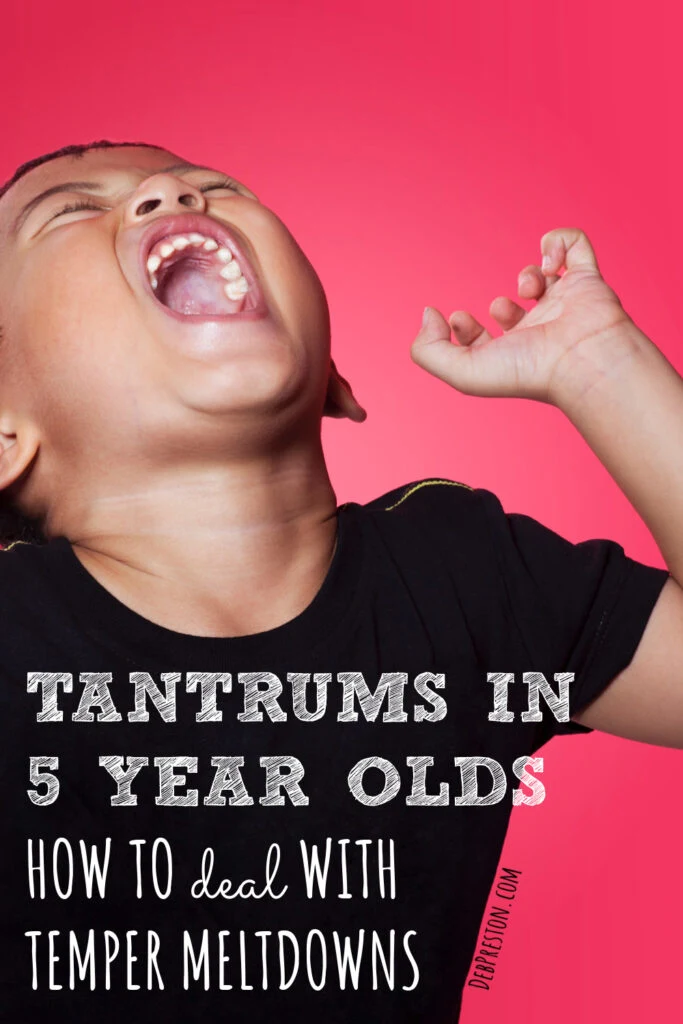Lots of people experience toddler tantrums during the terrible twos. And threenagers? Psh, they like to slather a know-it-all attitude on top of the tantrums!
But…what happens when the tantrums never quite stop? Or…what if they stop for years, then make a jaw-dropping resurgence? What if your child’s frequent tantrums are beginning to affect your daily life?
The fact is that experiencing tantrums with older children is incredibly common! And learning the best way to deal with those tantrums in 5 year olds may present a difficult time for parents and caregivers, especially those who assumed they were in the clear by now.
At this age, children are learning to express big feelings but may not yet have the necessary language or coping skills to effectively communicate their needs and frustrations. As a result, tantrums are, unfortunately, a normal part of their emotional development.
In the following sections, we’ll discuss essential techniques to handle tantrums in 5-year-olds, as well as highlight when you may need to seek professional assistance with older children. Throughout this journey, remember that patience, empathy, and consistency are key to helping your younger children learn to manage their emotions in a healthy way.
Understanding Tantrums in 5 Year Olds
The first step of learning to deal with tantrums is to recognize that tantrums in 5 year olds are a normal part of development.
These emotional outbursts often stem from big emotions like anger, frustration, fears, worries, sadness, hunger, tiredness, overwhelm, and even changes in routine, resulting in tantrum behaviors like kicking, screaming, hitting, and biting. As a parent, understanding the reasons behind these tantrums can be extremely helpful in managing and coping with them.
At this age, children are becoming more capable of identifying and labeling their big emotions, but they may still struggle to express them appropriately. This difficulty in communication can lead to tantrums and meltdowns.
Additionally, 5 year olds have a strong desire for autonomy, and their need to assert their independence and make decisions for themselves can sometimes result in tantrums.
When dealing with tantrums, the best way to maintain your own sanity is to remember a few key points:
- Stay calm and composed during the tantrum.
- Offer comfort and reassurance to your child.
- Try to understand what’s causing the frustration.
- Encourage your child to use words to express their feelings.
Overall, while tantrums in 5-year-olds are a challenging aspect of parenting, it’s important to remember that they’re a normal part of development, even for slightly older children.
Understanding the reasons behind these tantrums is the first step to helping your child navigate through this emotional phase more smoothly. So…let’s dive into some of the causes of tantrums in 5 year olds!
Causes of Tantrums in 5 Year Olds
Physical Triggers
Some of the most common triggers of tantrums in 5-year-olds can be traced to physical factors.
When young children are tired or hungry, their patience may wear thin and they may be more prone to tantrums. (Heck, you might even feel the same!)
To minimize the occurrence of tantrums related to tiredness or hunger, try to ensure that your child gets enough sleep and regular healthy meals.
Emotional Triggers
Emotional factors also play a significant role in tantrums.
Feelings of anxiety, stress, and frustration can overwhelm your child, leading to emotional outbursts. Your child may also experience frustration when they struggle with learning independence or adapting to changes in their routine.
Acknowledging their feelings and providing a supportive environment can help reduce emotionally-driven tantrums.
Environmental Triggers
The environment around your child is full of common triggers that may contribute to tantrums as well.
Overstimulation from bright lights or loud noises can cause discomfort and agitation, making your child more prone to tantrums. Creating a calm and soothing environment when possible will help your child feel more comfortable and less likely to have a tantrum.
Signs of a Tantrum in 5 Year Olds
It’s incredibly normal for your 5-year-old child to experience tantrums, but it’s essential to understand and recognize the signs of a tantrum. In doing so, you’ll be better prepared to help them navigate their intense feelings and tackle any challenges they’re facing.
Here are some common indicators of tantrums in 5-year-olds:
- Kicking: In moments of intense frustration, young children might start kicking objects or even people around them. This is often a method they use to let out their pent-up energy and convey their feelings.
- Screaming: A go-to reaction for many children during a tantrum is screaming. It’s an emotional release that signifies they’re feeling overwhelmed, angry, or upset.
- Crying: Crying is another typical tantrum sign. It can manifest in anything from sniffles to full-on sobbing, depending on the intensity of the situation.
- Outbursts: Sometimes, tantrums can come in the form of sudden, unpredictable outbursts, making it harder for you to anticipate and address them. These emotional outbursts may include yelling or lashing out physically.
- Self-injurious behavior: In some cases, 5-year-olds might harm themselves during a tantrum. While this might present an alarming sight, it’s important to stay calm and gently redirect their behavior.
- Hitting: Children often resort to hitting others or objects during a tantrum as a means of expressing their frustration. Like any other physical action, this behavior needs to be addressed with understanding and patience.
When you notice these signs in your child, it’s crucial to remember that tantrums are a normal part of their developmental journey. Approach the situation with a supportive attitude to help your child learn healthier ways to manage their emotions.

The Course of A Tantrum
Ascending Phase
During the ascending phase of a tantrum, you may notice your child’s frustration building up. They might start with crying or whining, and as their emotions escalate, so will their actions.
Screaming and even kicking can occur during this phase. It’s essential to remain calm and try to understand the cause of their emotional outbursts.
Crescendo Phase
When the tantrum reaches its peak, or the crescendo phase, your child’s behavior may become more severe. This phase is characterized by intense feelings and actions, including crying, screaming, and even kicking or hitting objects.
Your child’s outburst can appear overwhelming at this point. Remember to maintain a calm tone and ensure their safety, as well as the safety of others around them.
- Crying: Loud and inconsolable crying often dominates this phase.
- Screaming: Your child might scream loudly in an attempt to express their emotions or gain your attention.
- Kicking: Frustration can lead to physical manifestations, like kicking objects or flailing around.
Resolution Phase
Eventually, the tantrum will enter the resolution phase. During this time, your child’s emotions and actions may begin to subside.
The crying, screaming, and kicking often lessen in intensity, and you might notice signs of fatigue or rest. This is an excellent opportunity to calmly address your child’s emotional needs and help them regain their composure.
- Rest: Encourage your child to take a moment to sit or lie down and regain their composure.
- Reassurance: Offer comforting words and reassurance, letting your child know you understand their feelings and are there to support them.
As you navigate these phases, always remember to remain patient, understanding, and empathetic toward your child’s emotions. By maintaining a reassuring tone and keeping your own emotions in check, you can help guide your child through the challenging experience of a tantrum.
How to Respond to Tantrums in 5 Year Olds
And so…the million-dollar question…how should you respond to tantrums in 5 year olds? What’s the best way to approach it all?! Luckily, you have lots of options!
Staying Calm
It’s crucial to remain composed when dealing with tantrums. Even young children can sense your emotions – which means if you’re agitated, it can and will escalate the situation.
That’s why the most effective way to deal with tantrums is to demonstrate healthy emotional management through your own example. Young children may not hear what you say but will see what you do on a regular basis.
So take a few deep breaths and remind yourself that tantrums are a normal part of child development. Show your child that you respect their emotions, while maintaining your own emotional control. You can even invite them to take some deep breaths with you if you believe they might be open to it.
Distraction Techniques
Using creative ways to distract your child during a tantrum can help in calming them down. You can engage their curiosity by pointing out something interesting nearby or try to make them laugh with a funny action or phrase.
I personally found this to be the most effective way to deal with my daughter’s toddler tantrums, especially if I was pointing out a pet or stuffed animal “talking” to her about something unrelated. It’s important to remember that not all techniques will work for every child, so observe the most effective way to help your child and use it accordingly.
Implementing Timeouts
Lastly, timeouts can offer an effective response to tantrums. By providing a safe place for your child to calm down, you set clear boundaries for managing their behavior.
While many parents designate a “timeout chair” for younger children, we preferred to send our daughter to her room to cool down from big emotions. While her only option in a chair was to dwell on her intense emotions, her room provided the comfort of her bed and the distraction of her toys and favorite stuffed animals to help her reframe her thoughts.
Remember to praise your child for good behavior after a tantrum ends, reinforcing that their emotions are valid but timeouts are necessary for them to regain control. Find a consistent and age-appropriate duration for these timeouts and make sure your child understands the reason for this consequence.

Managing Aggressive Tantrum Behaviour
When dealing with tantrums in 5-year-olds, understanding and addressing aggressive behavior is crucial. We will explore some of the essential techniques for managing aggressive tantrums, focusing on hitting and throwing.
Handling Hitting
Hitting is a common aggressive tantrum behavior in children, but it’s important to maintain your composure as a parent.
First, help your child take a step back and calm down by calmly saying, “We don’t hit when we’re angry.” Then, encourage them to express their feelings verbally and come up with alternative solutions.
Be sure to praise them when they demonstrate proper self-control.
Remember to stay consistent with enforcing consequences when your child hits, such as taking the toy away if the tantrum occurred due to a disagreement about it.
Dealing with Throwing
Throwing objects is another behavior that might accompany a tantrum.
To curb this behavior, consider setting clear boundaries beforehand. Let your child know that throwing things is not acceptable and there will be consequences if it happens.
When your child starts throwing objects during a tantrum, calmly warn them that they’ll lose the privilege to play with that specific toy for the rest of the day. Assist them in coping with their emotions and help them switch to a more acceptable behavior, such as talking about their feelings or engaging in a calming activity.
Remember, addressing aggressive tantrum behavior requires patience and consistency. By remaining calm, providing emotional support, and implementing consequences, you’ll be able to help your child develop healthier ways to manage their emotions.
Prevention of Tantrums in 5 Year Olds
While dealing with tantrums in the moment is a necessary skill, preventing tantrums altogether is the best way to manage tantrums.
To experience fewer tantrums, try implementing these strategies:
Establish a routine: Design a fixed routine for your child to follow, including regular nap times, meal times, and play times. Consistency offers a safe space where your child can feel more secure and better understand what is expected of them.
Be mindful of needs: Pay attention to your child’s needs such as hunger, tiredness, or boredom.
When running errands, try to avoid times when your child is usually hungry or tired. If you’re expecting to wait in line, pack a small toy or snack to occupy your child and keep them happy.
Offer choices: Give your child opportunities to make appropriate choices. For instance, let them choose between two food options or between two shirts to wear.
This can help your child feel a sense of control and autonomy, reducing the chances of meltdowns.
Encourage language development: Help your child build their language skills so they can better express their feelings, and frustrations. When they’re able to communicate their needs effectively, tantrums will be less likely to occur and present a less difficult time when they do.
Praise good behavior: Make sure to acknowledge and praise your child’s good behavior and efforts. Giving them two to three labeled praises for every one corrective or negative statement can create a positive environment and encourage more positive behaviors.
Be consistent with discipline: Implement a behavior management plan and follow through with consequences for negative behavior. Make sure you share this with any family members or other caregivers in your child’s life to ensure consistency and avoid confusion.
Stay calm and composed: When a tantrum does happen, try to remain calm and composed.
Acknowledge your child’s feelings but do not give in to their demands. Maintain your assertiveness and model appropriate emotional regulation.
By incorporating these prevention tips into your daily routine, you can create a more positive environment and reduce the likelihood of tantrums in your 5-year-olds.
Tantrums in Public Places
Handling tantrums in public places can feel like a daunting task, but with a little patience and understanding, you can learn how to tackle these challenging moments. Here are a few tips to help you navigate tantrums in a public setting.
Firstly, try to stay calm.
When your 5-year-old starts to throw a tantrum, it’s essential to keep your composure. Take some deep breaths, remind yourself that tantrums are a normal part of a child’s development, and maintain a positive, calm attitude.
Another crucial step is not to give in to your child’s demands just because you are in a public space.
Remember, being consistent with your approach in dealing with tantrums is essential, whether in private or public places. Giving in might send the wrong message to your child, and it may encourage them to throw more tantrums in the future.
It’s also important to validate your child’s feelings. Try to understand the situation from their perspective and acknowledge their frustration.
You can say something like, “I understand you’re feeling upset because we can’t buy that toy right now”. Providing empathy and reassurance can be helpful in calming them down.
While your child is having a tantrum, consider removing them from the situation temporarily to a safe place, if possible.
This can be helpful in diffusing the tension and allowing them to calm down. For example, if you’re in a grocery store, take a brief break outside until they regain control of their emotions.
Finally, try to keep in mind that children having tantrums in public is a common occurrence, and you don’t have to feel embarrassed.
Remember that most people understand that parenting is a challenging job, and they’ve likely experienced similar situations with their own children. So, stay confident in your parenting skills and focus on handling the tantrum in a developmentally-appropriate manner, rather than worrying about what others might think.

When to Seek Professional Help With Tantrums in 5 Year Olds
As a parent, you want to ensure that your child receives the best support possible. Identifying when your child’s tantrums and potential red flags may warrant professional help is essential.
Here are some indicators that can help you determine if it’s time to consult a specialist.
If your child’s severe tantrums and/or frequent tantrums are affecting their daily life, or involve self-injurious behavior, it’s crucial to seek professional help. These red flags might indicate an underlying condition such as autism spectrum disorder, oppositional defiant disorder, or a developmental delay.
It’s also essential to monitor your child’s overall temperament.
If younger children or even older children have stopped enjoying activities they used to love, they may be struggling with emotional or psychological issues. A pediatrician or child psychologist can help identify potential root causes and provide guidance on appropriate interventions.
While it’s normal for tantrums to last between a few minutes and 15-20 minutes, prolonged tantrums may be concerning. If your child’s tantrums consistently last longer than 20 minutes, it’s worth discussing with a healthcare professional.
Remember, you know your child best, and there might be times when a gut feeling tells you that something isn’t quite right.
Trust your intuition and don’t hesitate to reach out for help. A pediatrician or mental health professional can provide valuable insight and support for both you and your child.

And there you have it…how to manage tantrums in 5 year olds.
It’s frustrating. It’s exhausting. Frankly, it’s maddening.
But now you have a toolbelt full of tips and encouragement to make it through to the other side. You’ve got this, friend!
Do you have any tips or tricks for your fellow readers dealing with tantrums in 5 year olds? Be sure to sound off in the comments!
Frequently Asked Questions
How can I help my child handle tantrums at school?
To help your child handle tantrums at school, first, maintain a consistent routine and set clear expectations for them. Encourage communication, teach them how to express their feelings verbally, and remind them that parents and teachers will always offer a safe place for sharing feelings.
Developing coping skills for managing emotions can also be beneficial in preventing tantrums. Collaborate with your child’s teacher and school staff to create a supportive environment for them.
What strategies can I use when my 5-year-old refuses to listen?
When your 5-year-old refuses to listen, stay calm and avoid reacting emotionally. Offer choices to give them a sense of control.
Use clear and concise language to communicate your expectations. If necessary, enforce consequences with a focus on natural and logical outcomes.
Additionally, try rewarding good behavior with praise or special privileges to reinforce good listening habits.
What causes emotional meltdowns in children?
Emotional meltdowns in children can be triggered by various factors, with common triggers including frustration, stress, fatigue, hunger, or overstimulation. Children may struggle to cope with these emotions, resulting in outbursts.
Remember that temper tantrums are common in early childhood, and they usually decrease between ages 42 and 48 months.
How can I address worsening tantrums in my child?
If your child’s tantrums seem to be worsening, consider observing patterns and identifying common triggers for the outbursts. Offer a timeout in a calm, neutral space when necessary.
Consistent consequences and clear expectations can help manage tantrums. If the issue persists or there is a significant impact on daily life, consult your pediatrician or a child psychologist for guidance on a more effective way to approach your child’s unique situation.
How do I handle a 7-year-old’s tantrum when told no?
Handling a 7-year-old’s tantrum requires patience, consistency, and understanding.
Remain calm and composed while empathizing with their emotions. Explain the reason for saying no and offer alternatives or compromises where appropriate.
Consistently enforce consequences for negative behavior and acknowledge positive behaviors whenever possible.
What are signs of ADHD-related tantrums?
ADHD may contribute to your child experiencing more intense, prolonged, and/or frequent tantrums. Impulsivity and difficulty self-regulating emotions can contribute to these outbursts.
The best way to approach the situation if you suspect your child’s tantrums may be related to ADHD, is to seek professional guidance from a pediatrician or child psychologist for an accurate assessment and support. Many different diagnoses, including ADHD, autism spectrum disorder, oppositional defiant disorder, developmental delays, and more, could be contributing to your child’s severe tantrums.

P.S. Could you use some extra help with your stress levels? Download A Practical Guide to Stress | 17 Tricks to Take Control of Stress Today to help you develop a game-changing stress management plan. It’s free! Get yours HERE.
Disclosure: While all opinions are our own, we are a participant in the Amazon Services LLC Associates Program and other affiliate advertising programs, designed to provide a means for us to earn fees by linking to Amazon.com and affiliated sites, at no additional cost to you.


